The UEFA Women’s Champions League has reached the last four stage, and, for the first time since the 2014-2015 season, it didn’t include Lyon Feminin. That means that there will be debut champions this year, with Bayern Munich, Chelsea Women, Paris Saint-Germain Feminine and Barcelona Femeni having never won the competition before. This tactical analysis looks at the first leg of the tie between PSG and Barcelona, which ended 1-1. We will focus on PSG’s mistakes and second half changes, which helped them pose more of a threat after half-time, as well as Barcelona’s attacking tactics and mistakes during the game.
Lineups
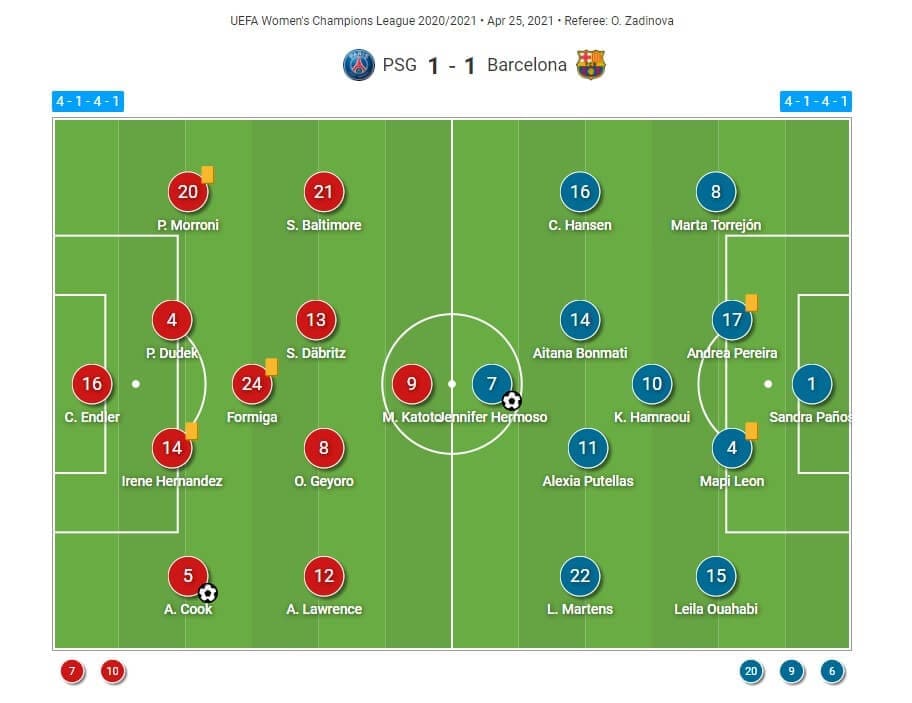
PSG Feminin set up with a 4-1-4-1 formation, naming their strongest available team. The most notable omission was forward Kadidiatou Diani, who was injured. That meant that Canada full-back Ashley Lawrence was pushed forward to right wing, with USA defender Alana Cook coming into the defence in her place. Captain Irene Paredes played alongside Poland international Paulina Dudek, whilst former Brazil player Formiga was in the hole between the defence and midfield. Forward Sandy Baltimore, who was exceptional for France in the recent international fixture against England, lined up on the left wing, with the highly-rated Marie-Antoinette Katoto leading the line in attack.
Barcelona Femeni also started with a 4-1-4-1 formation. Former Liverpool Women and Arsenal Women striker Asisat Oshoala recovered from a foot injury to take her place on the bench, with Spain star Jennifer Hermoso starting upfront. Patricia Guijarro was suspended for this leg, so former PSG midfielder Kheira Hamraoui started in defensive midfield, allowing Aitana Bonmati and Alexia Putellas to direct play from the centre of the pitch. Norway’s Caroline Graham Hansen and the Netherlands’ Lieke Martens started as the wingers, with both given the freedom to drift inside when needed.
Barcelona Femeni’s attacking play
Barcelona Femeni had the better start to the game, playing on the front foot and putting pressure on their opponents.
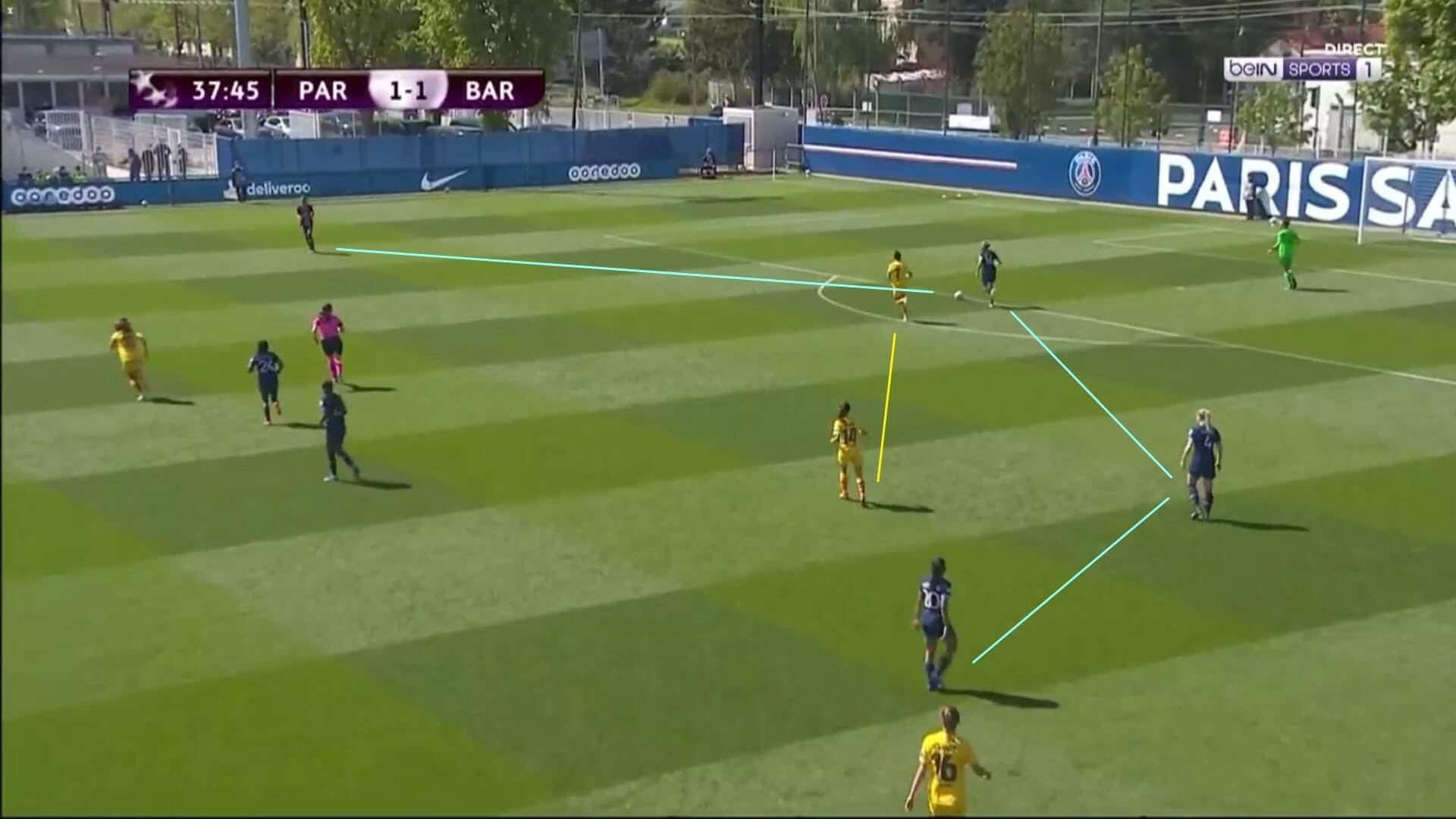
Their formation is never rigid, with players always encouraged to move around the pitch, filling spaces and supporting each other, and this was part of their tactical game plan here too. By moving around the pitch, they ensured that PSG Feminine had to keep their concentration, because any small gaps they left would be punished by Barcelona’s attackers.
To demonstrate their in-game flexibility, they have changed to a 4-4-2 in this image, with Hamraoui moving into the midfield line, whilst Bonmati has gone forward to support Hermoso. This gives Barcelona a link between the midfield and attack, as well as an attacking partnership who can now press their opponents more effectively. At other times, Hermoso dropped back into the midfield, switching with Putellas or Bonmati, who then acted as a false nine. This then provided Barcelona with a pivot player, helping them to move the ball into dangerous areas. Therefore, we see how Barcelona’s constant player movement gave them different options around the pitch, which was key in them taking control of this match early on.
To counter this tactic, PSG set up with a wide defensive formation, trying to create as much space as possible to keep possession under the constant pressure from Barcelona. This defensive structure meant they always had a player available to move the ball to, depending on where Barcelona’s players were, so PSG effectively beat the press with this setup.
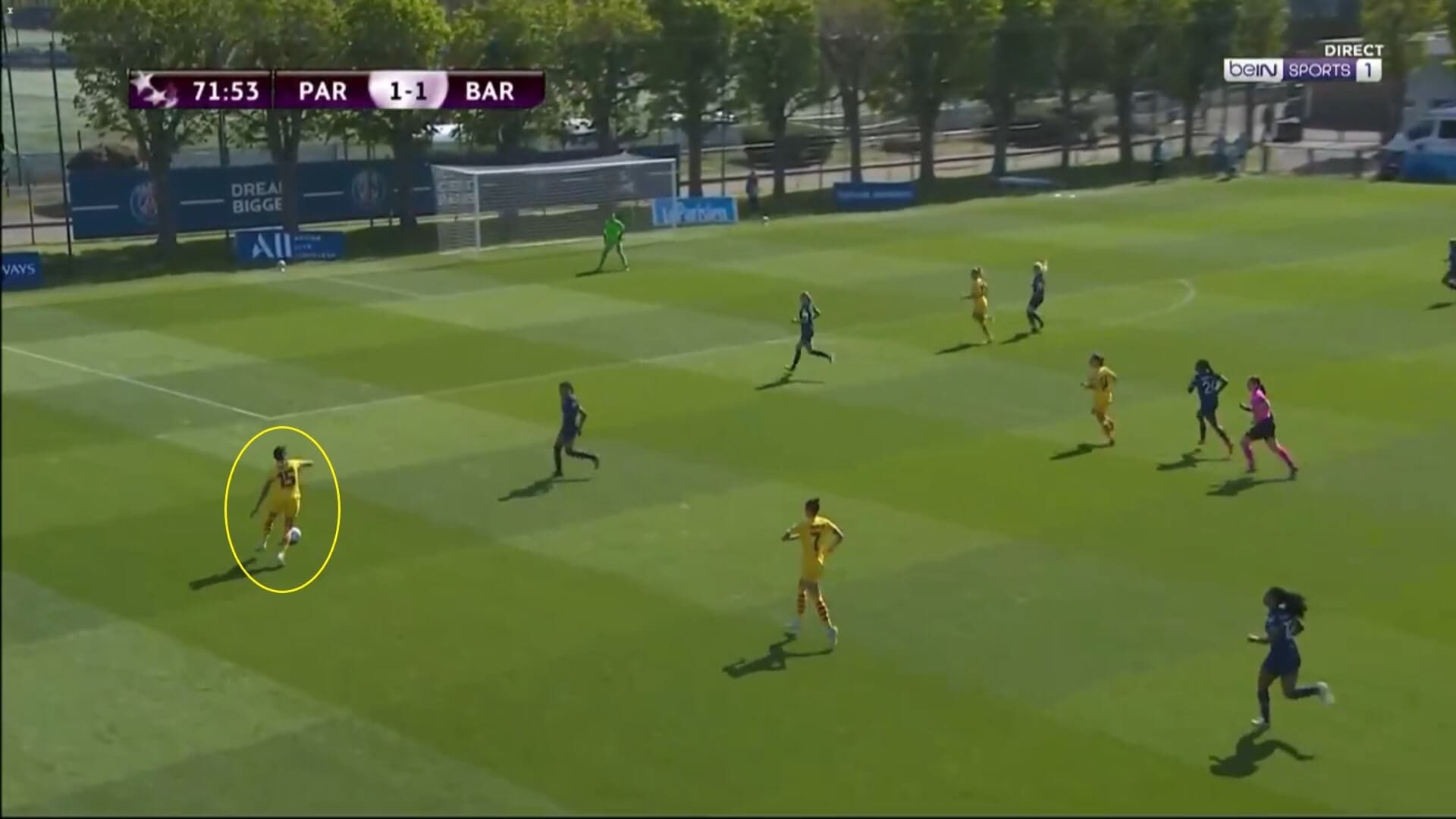
The other feature of Barcelona’s attacking play was quick, fluid passing, ensuring they could access spaces around the field. The key players in this were their full-backs, who got up the pitch well and controlled the wings, taking up positions behind PSG’s defence as often as possible. Here, left-back Leila Ouahabi has got into one such dangerous area, and is now looking to cross the ball into the box. Therefore, we can see how their positioning in attack, and ability to find players in threatening areas, was crucial to them creating chances to score.
Barcelona were always calm in possession, never pushing the ball too far and risking an interception being made. If there was no option further up the pitch, they simply played the ball backwards, working together to build from the back again, and this was another reason why they controlled the majority of the first half.
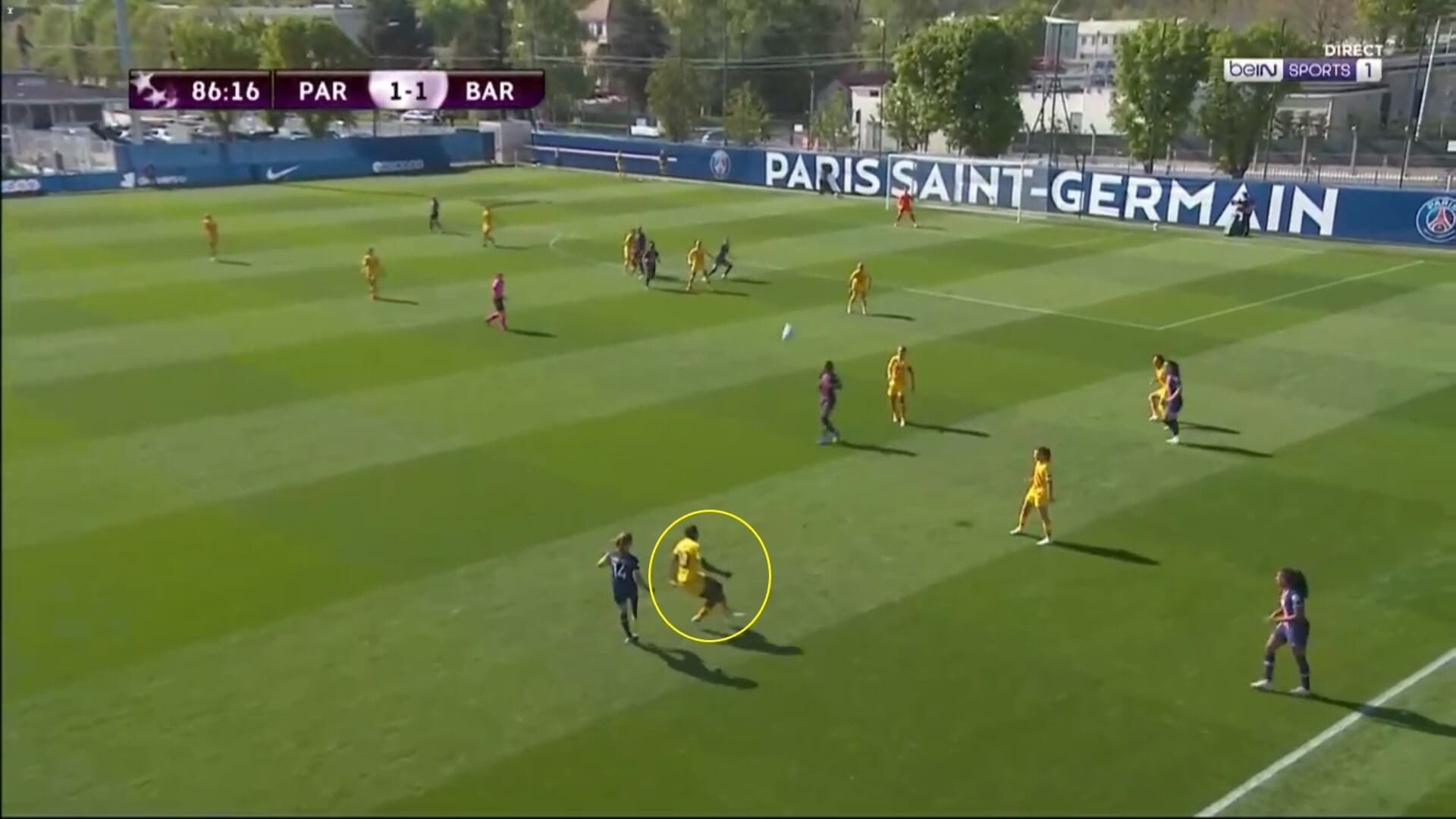
Hermoso suffered an injury in the second half, whilst Lieke Martens’ influence on the game lessened, so Barcelona coach Lluis Cortes made a change to give them more energy in the closing stages. Mariona Caldentey and Asisat Oshoala came on, and immediately the pressure and energy that we saw from Barcelona in attack in the first half returned.
They also changed to a more counter-attacking style of play in the second half, sitting back when PSG had possession, whilst Oshoala was tasked with moving around the field and closing down whichever PSG player had the ball. Here, home captain Irene Paredes has made the pass up the field, and we can see how Oshoala has come across towards her, narrowly missing out on making the block. This intensity was what Barcelona had lost as the game had gone on, and so the substitutes had a positive effect on their overall performance.
Barcelona Femeni’s mistakes
However, it wasn’t a perfect game from them, with errors being made that cost them in some parts of the match.
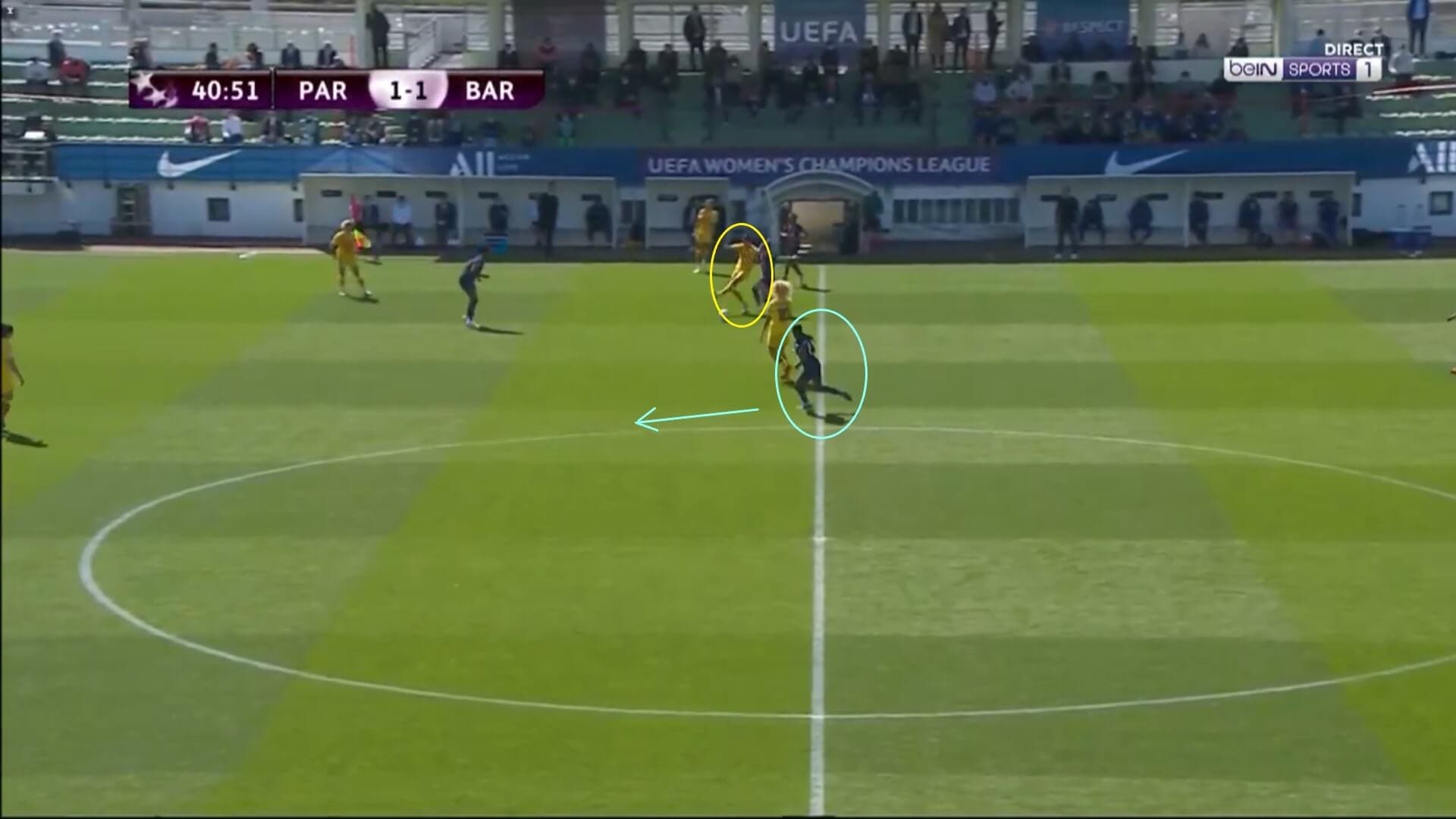
Here, they have been a little careless in possession, with PSG Feminine running forward to close them down. As they settled into the game, the home side began to anticipate play more, looking to get tight to the Barcelona Femeni players and force errors like this, which they could then attack from. Their pressure has forced Barcelona to mishit the ball here, allowing Grace Geyoro to set up Marie-Antoinette Katoto with a pass through the Barcelona defence. Whilst Katoto’s shot hits the post, letting Barcelona off, this was a warning for the visitors that any small mistakes they made would be punished.
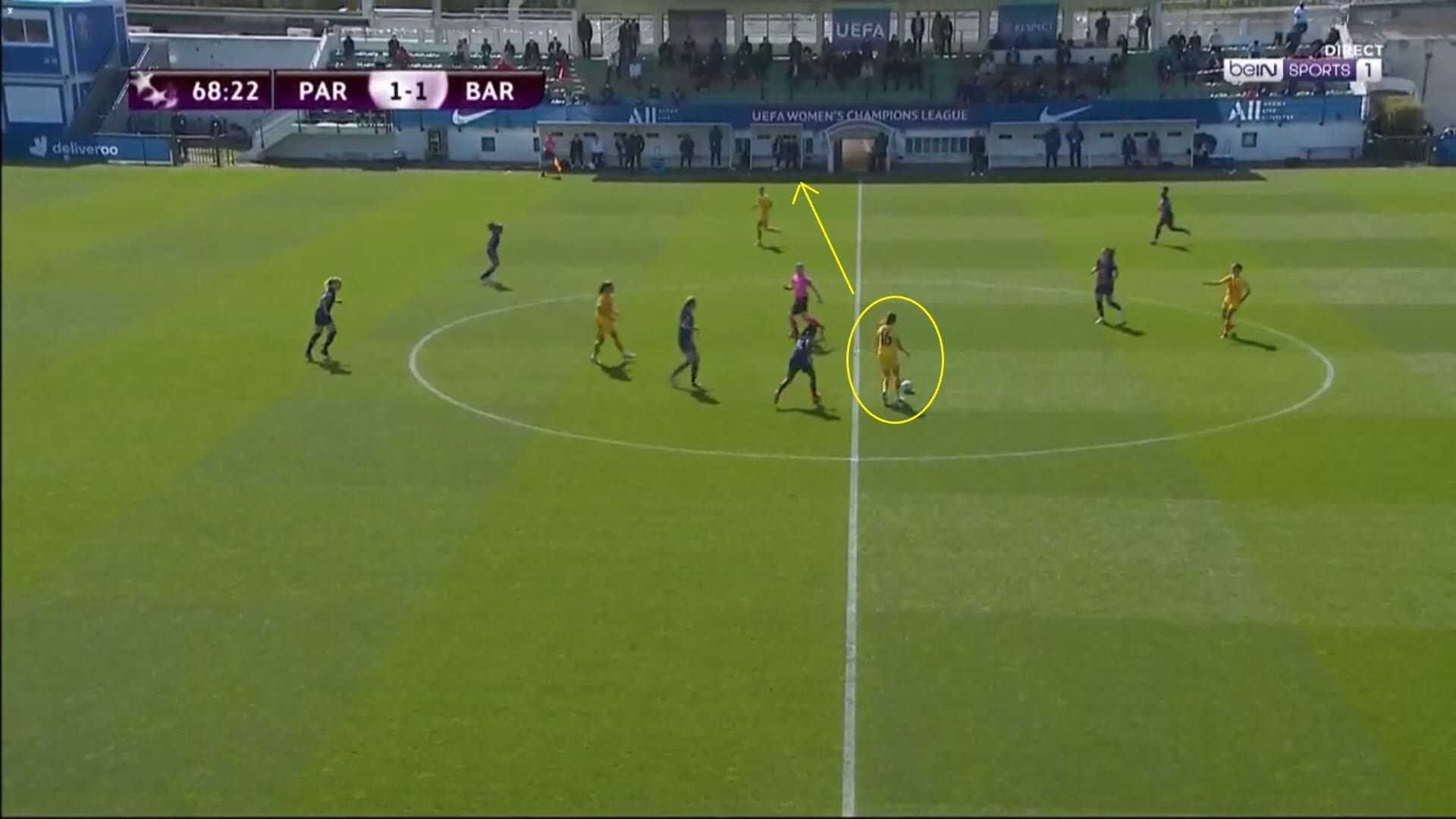
In the second half, loose passes started to creep into their play more, with them lacking the composure with the ball that they had shown in the first half. We have already mentioned how they started and finished the game well, but the central part of it was where they made mistakes like this, preventing them from putting the game to bed when they had opportunities to do so.
This image shows one example of their untidy passing. Hansen is in the middle of the pitch, turning and looking to play the ball out to her teammate on the wing. However, it goes behind her and harmlessly out of play, as the yellow arrow shows. Given the narrow setup of PSG’s defence here, this would have been a good chance to potentially secure a second away goal, but the mistake meant that the opportunity was wasted.
PSG Feminine’s errors
As well as Barcelona Femeni, PSG Feminine had good and bad parts to their game, leading to the eventual 1-1 draw. They struggled to get into the first half, unable to cope with the initial threat posed by the away side.
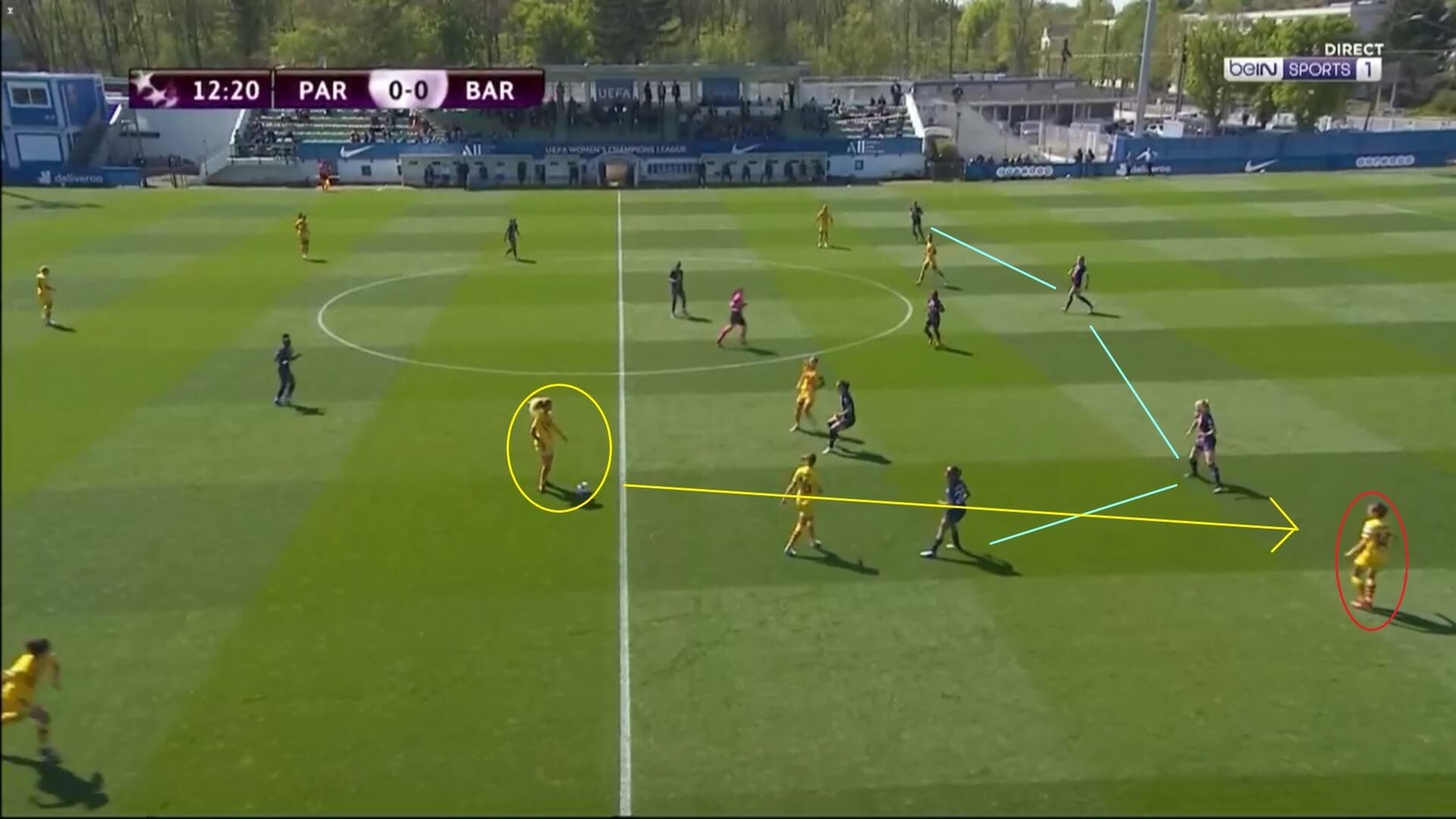
This was because PSG gave them opportunities to attack behind them. Here, we see how their defence has advanced up the pitch, but left-back Perle Morroni has gone too far, opening up the space behind her for Barcelona to exploit.
We mentioned previously how Aitana Bonmati and Alexia Putellas were constantly moving around the pitch, being the furthest forwards at times. This is the type of situation they were looking for, with Bonmati getting behind the defence and giving Hamraoui a passing option there. This is actually the build-up to Barcelona’s goal, scored by Hermoso, so we can again see how small mistakes were being punished. PSG will look at this situation and know they gave Barcelona their away goal too easily, and that it could be a bad mistake to make in such a tight Champions League tie.
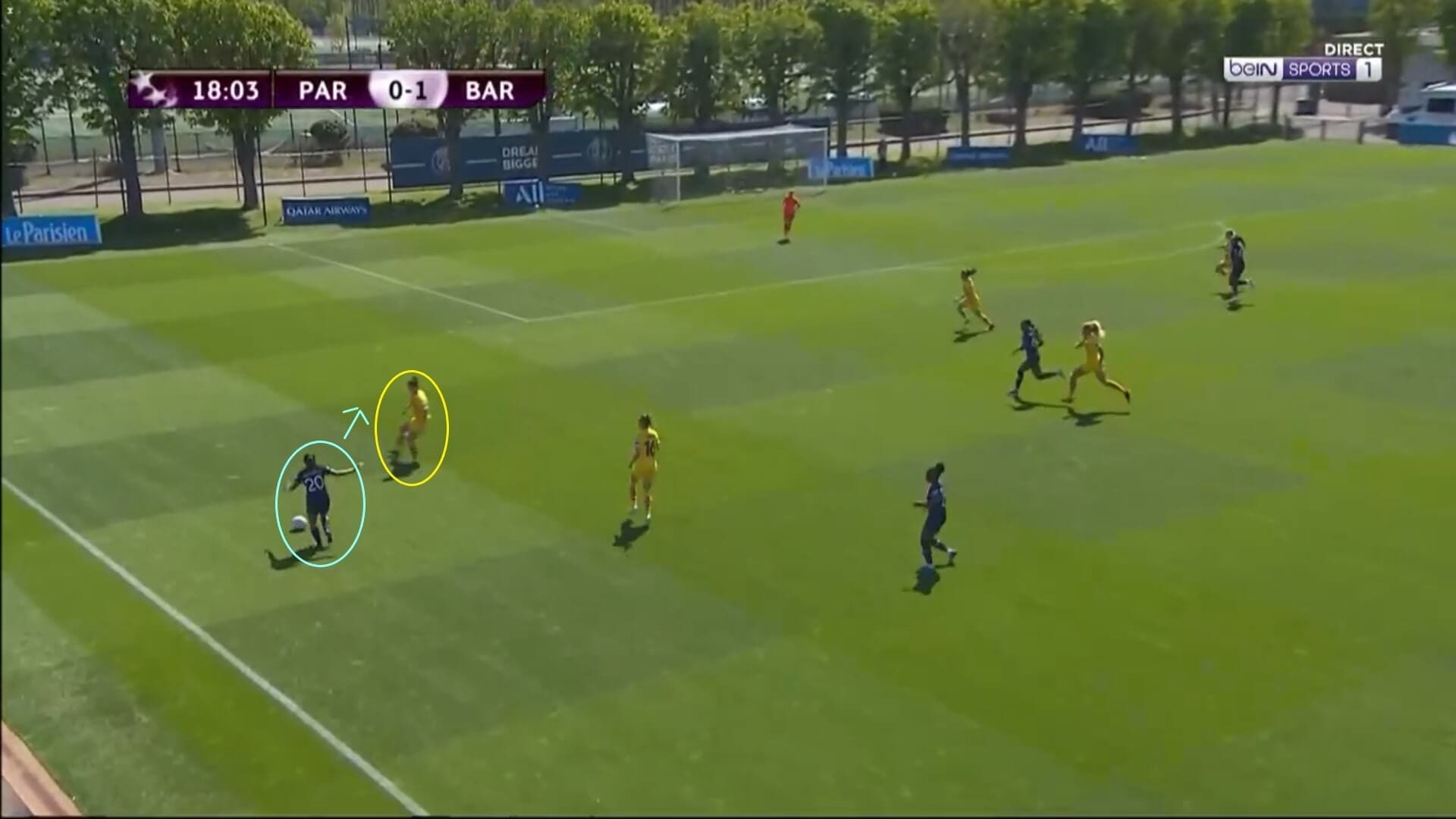
It wasn’t just in defence that PSG made errors. Here, Morroni has got up the pitch into space, and is looking to set up a teammate inside the pitch to continue the attack. However, she ends up playing the ball too close to her opponent, as the blue arrow shows, and the opportunity ends with Barcelona clearing the ball to safety. When games like this are so tight, both teams need to make their opportunities count, and PSG didn’t here, lacking the composure to turn this good run into a potential shot at goal.
PSG Feminine’s second half improvements
It goes without saying that PSG Feminine needed to make changes in the second half, adding more quality to their game.
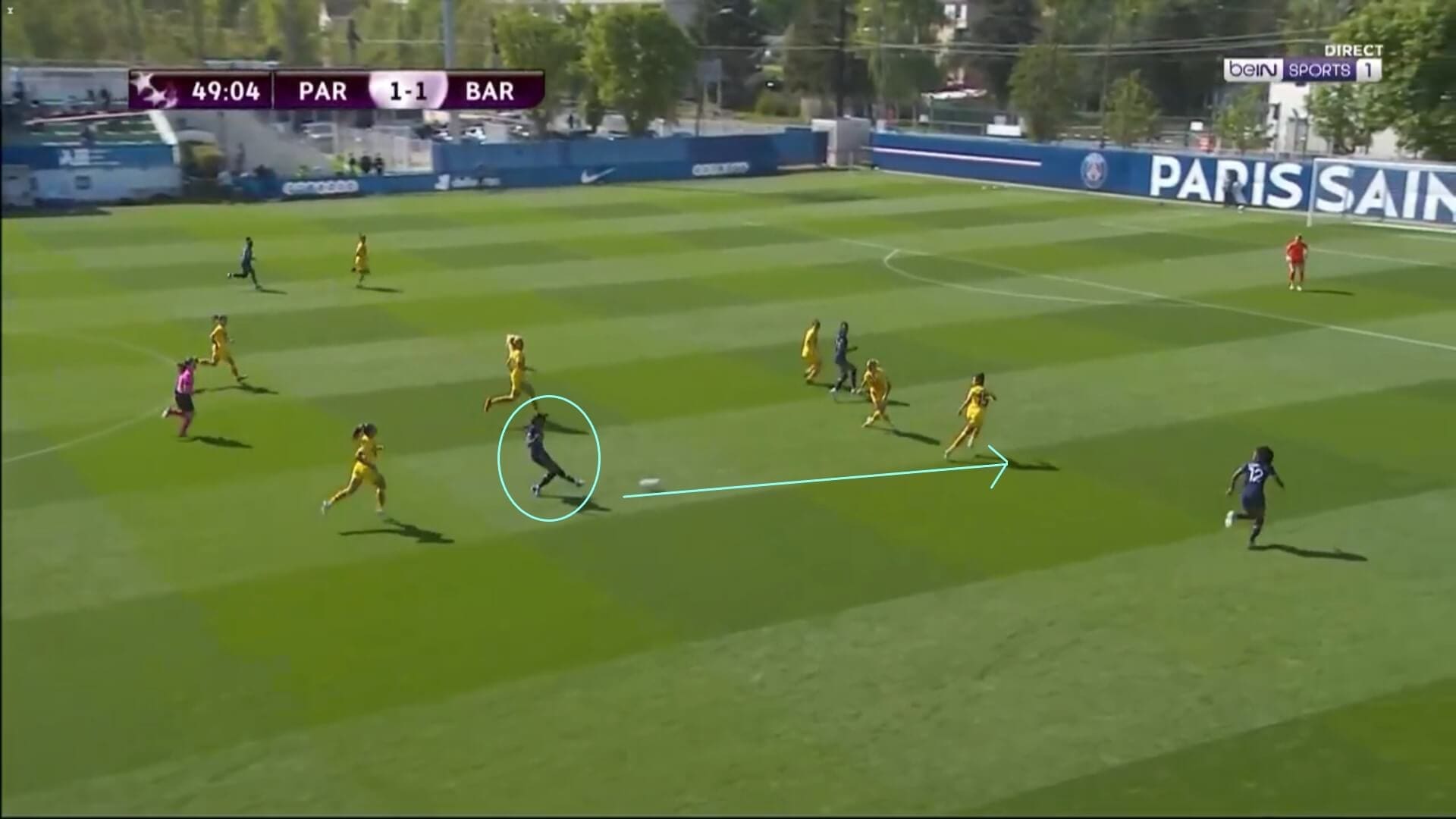
Something we had seen them attempting in the first half was to move the ball into Katoto and Sandy Baltimore behind the Barcelona defence, but they generally weren’t able to do this, as space was at a premium in Barcelona’s third. However, they stepped this up in the second half, and, every time they had possession, their first thought was always to move it forwards. More gaps were appearing in Barcelona’s defensive line in the second half, which PSG continually exploited with through passes and players getting between the individual defenders. As a result, Barcelona were forced onto the back foot more in the second half, trying to stop the home side getting behind them so often, but it was clear that PSG’s improved forward passing and attacking play helped them to take more control of the game.
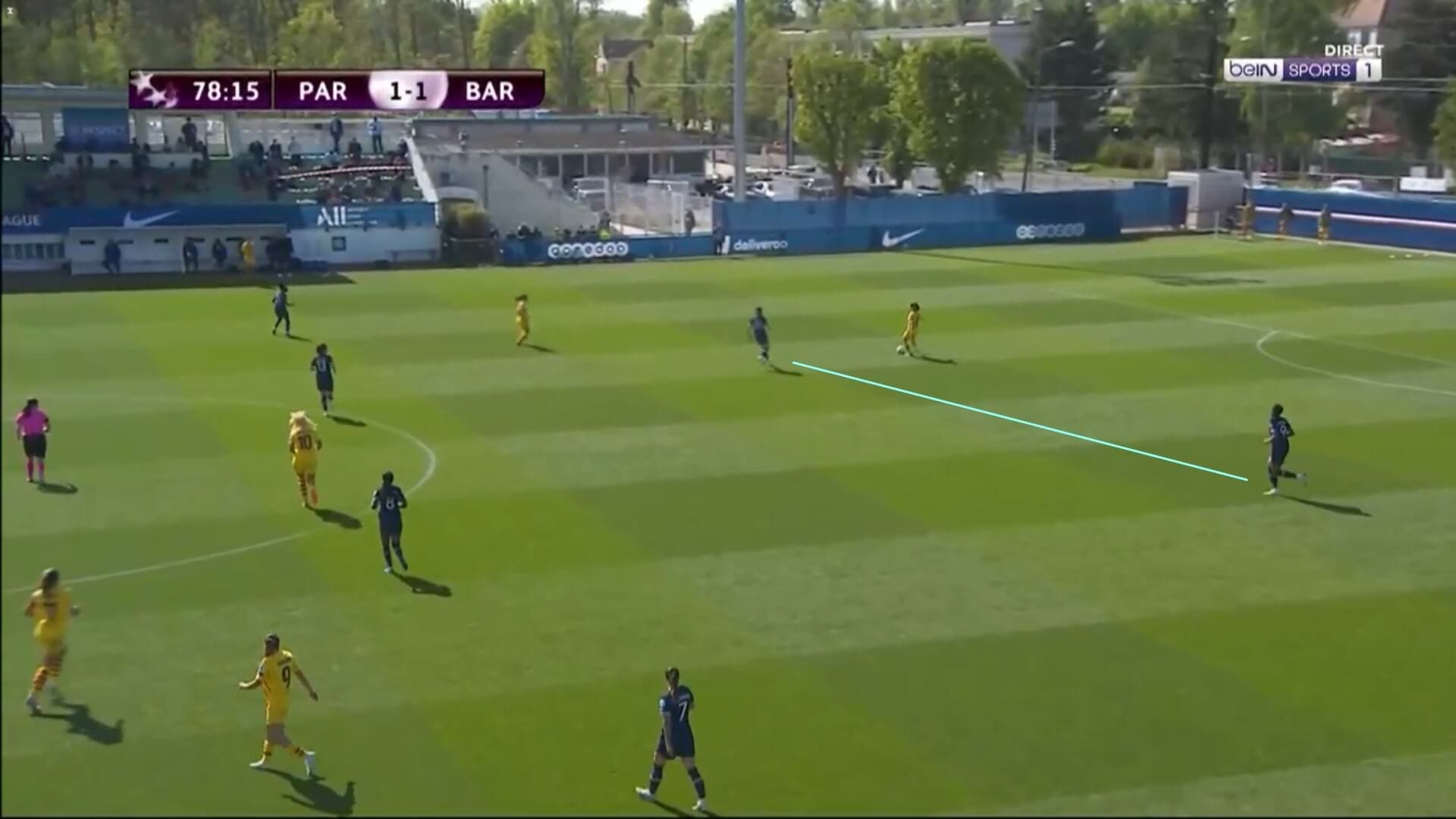
This newfound attacking confidence was also helped by their substitutions during the second half. Switzerland and former Chelsea forward Ramona Bachmann was introduced, replacing Alana Cook, and added pace to their attacking line, whilst Formiga was replaced by Denmark striker Nadia Nadim, who played alongside Marie-Antoinette Katoto in attack, as is shown in this image.
In making these alterations, PSG changed to a 4-4-2 formation, closing the gap between their defence and midfield and preventing Barcelona getting in between the lines. Bachmann is a player who carries a threat from wherever she is on the pitch, and helped create more opportunities for the strikers, whilst having Katoto and Nadim playing together allowed PSG to press Barcelona’s defenders with more purpose. As the game was reaching its closing stages at this point, PSG were looking to mix things up and try to force Barcelona to play the ball quicker, potentially leading to them making a mistake.
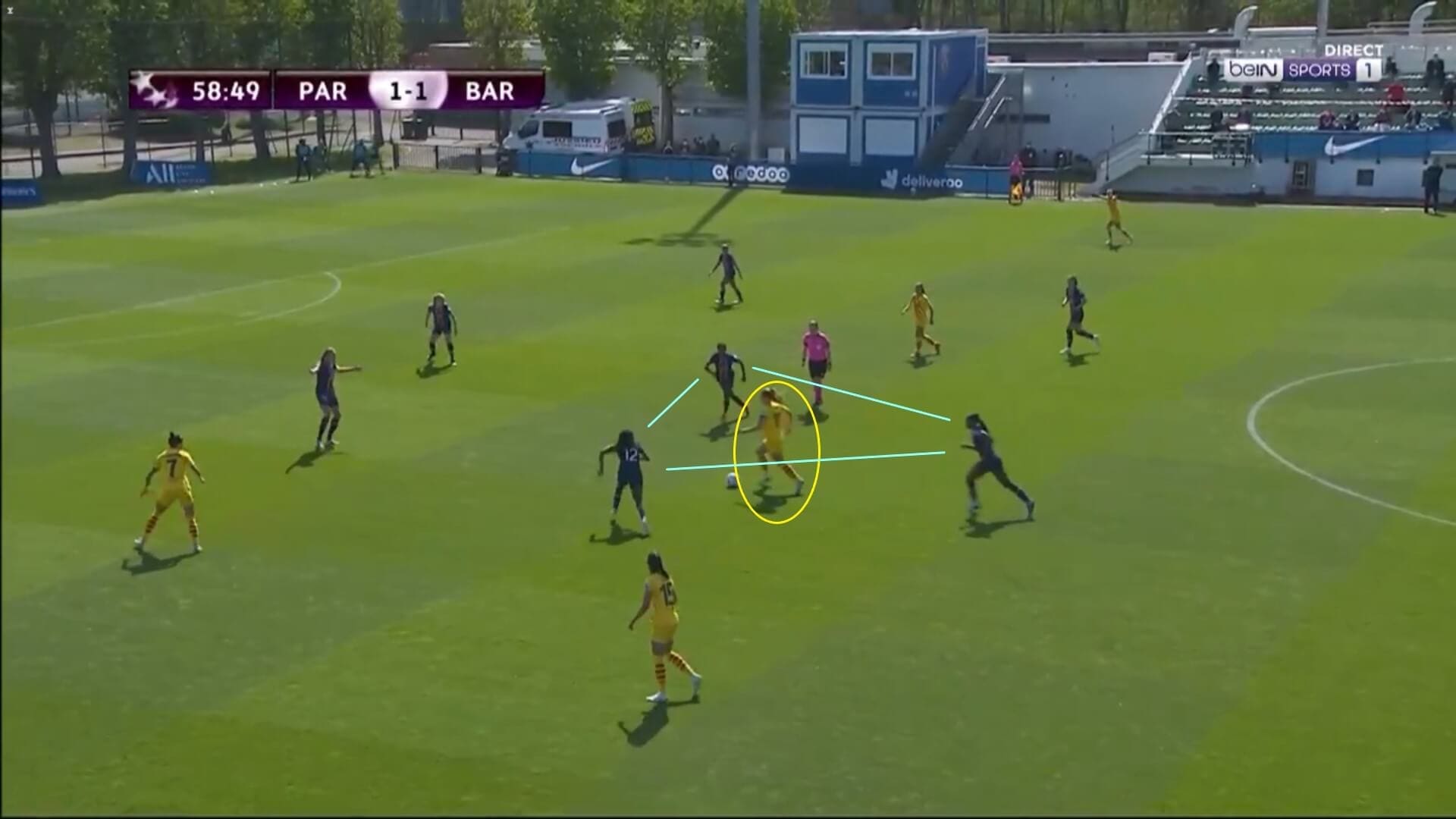
When it came to defensive improvements, PSG looked to ensure that Barcelona had less space to work with, constantly surrounding and closing them down in the second half. In this image, Alexia Putellas is advancing towards PSG’s goal, but has three opponents positioned around her. This forces Putellas to move the ball quicker, increasing the chance of her making an error. As previously mentioned, Barcelona struggled to get into the game after half-time, and this was as much to do with PSG having a better second half setup as it was to do with Barcelona’s mistakes.
Conclusion
In conclusion, the first leg of this UEFA Women’s Champions League semi-final was a closely-fought encounter, with both teams having opportunities to score and both sides making mistakes. This analysis has picked out the key features of each side’s play, focusing on how Barcelona Femeni controlled the first half, and how PSG Feminine made improvements tactically in the second half to get more into the game. The second leg takes place on Sunday morning, with the pressure definitely on PSG after Barcelona’s vital away goal, but both sides are still in it and have a chance of going through to the 2021 final.





Comments